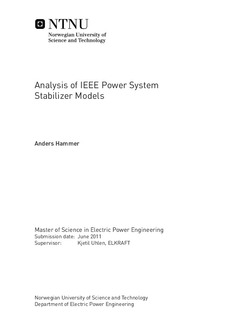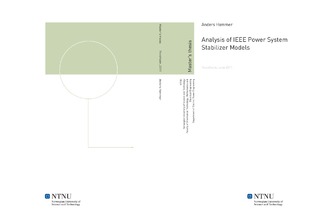| dc.description.abstract | Student: Anders HammerSupervisor: Kjetil UhlenContact: Daniel MotaCollaboration with: Voith HydroProblem descriptionIEEE (Institute of Electrical and Electronics Engineers) presented in 2005 a new PSS structure named IEEE PSS4B (Figure 0 1). Voith Hydro wants to analyse the pros and cons of using this new type compared to older structures. The PSS4B is a multi-band stabilizer that has three separate bands and is specially designed to handle different oscillation frequencies in a wide range. Until now, Voith Hydro has used the common PSS2B in their installations, but in the future they will probably start to implement the new PSS4B. This master thesis will seek to find an answer on following questions: How should the PSS4B be tuned to give the best damping of the local and inter-area oscillation mode? Will an implementation of PSS4B give a better result compared to PSS2B? What are the pros and cons of PSS2B and PSS4B? Figure 0 1: The multi-band stabilizer, IEEE PSS4B [1].MethodIn order to test and compare different PSS models, a simple two-area network model is created in a computer simulation programme (SIMPOW). One of the generating units is a hydro generator, which has a model of a static excitation system made by Voith Hydro. This network is characterised by a poorly damped inter-area oscillation mode, and in addition some local oscillation modes related to each machine. Different PSS structures (PSS2B and PSS4B) are then tuned and installed in the excitation system of the hydro generator, in order to improve the stability of the network. Different tuning methods of the PSS4B are designed, tested and later compared with the more common stabilizer the PSS2B. Simplifications are made where parts of the stabilizer is disconnected in order to adapt the control structure to the applied network and its oscillations. Totally 5 different tuning methods are presented, and all these methods are based on a pole placement approach and tuning of lead/lag-filters. ResultsInitial eigenvalues of the different setups are analysed and several disturbances are studied in time domain analysis, in order to describe the robustness of the system. Figure 2 illustrates the rotor speed of the generator, where the different PSS s are implemented. PSS4B is clearly resulting in increased damping of all speed oscillations in this network. The same results can also be seen in an eigenvalue analysis.Conclusion The best overall damping obtained in this master thesis occurs when the high frequency band of the PSS4B is tuned first, and in order to maximize the damping of the local oscillation mode in the network. The intermediate frequency band is then tuned as a second step, according to the inter-area oscillation mode. Results of this tuning technique show a better performance of the overall damping in the network, compared to PSS2B. The improvement of the damping of the inter-area oscillation mode is not outstanding, and the reason is that the applied machine is relative small compared to the other generating units in the network. The oscillation modes in the network (local and inter-area) have a relative small frequency deviation. A network containing a wider range of oscillation frequencies will probably obtain a greater advantage of implementing a multi-band stabilizer. | nb_NO |

